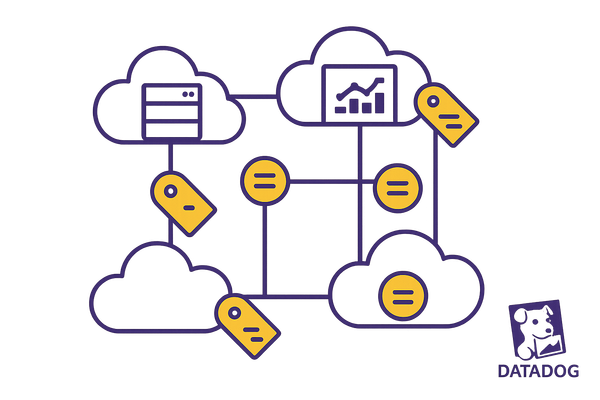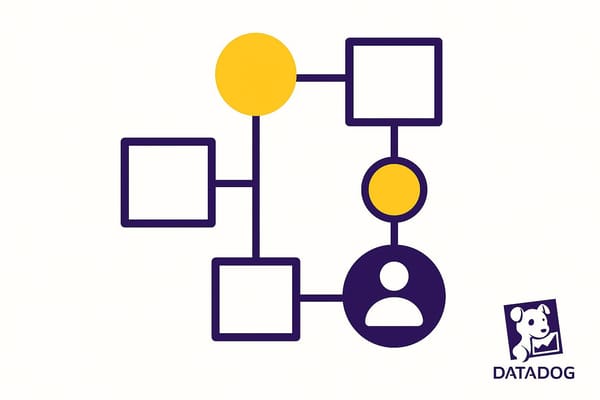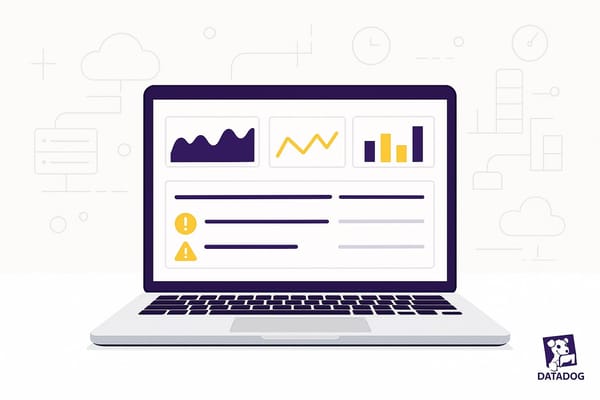Dynamic Thresholding Insights: Datadog Features Explained
Explore how dynamic thresholding in monitoring enhances alert accuracy, reduces false positives, and simplifies operations for growing businesses.
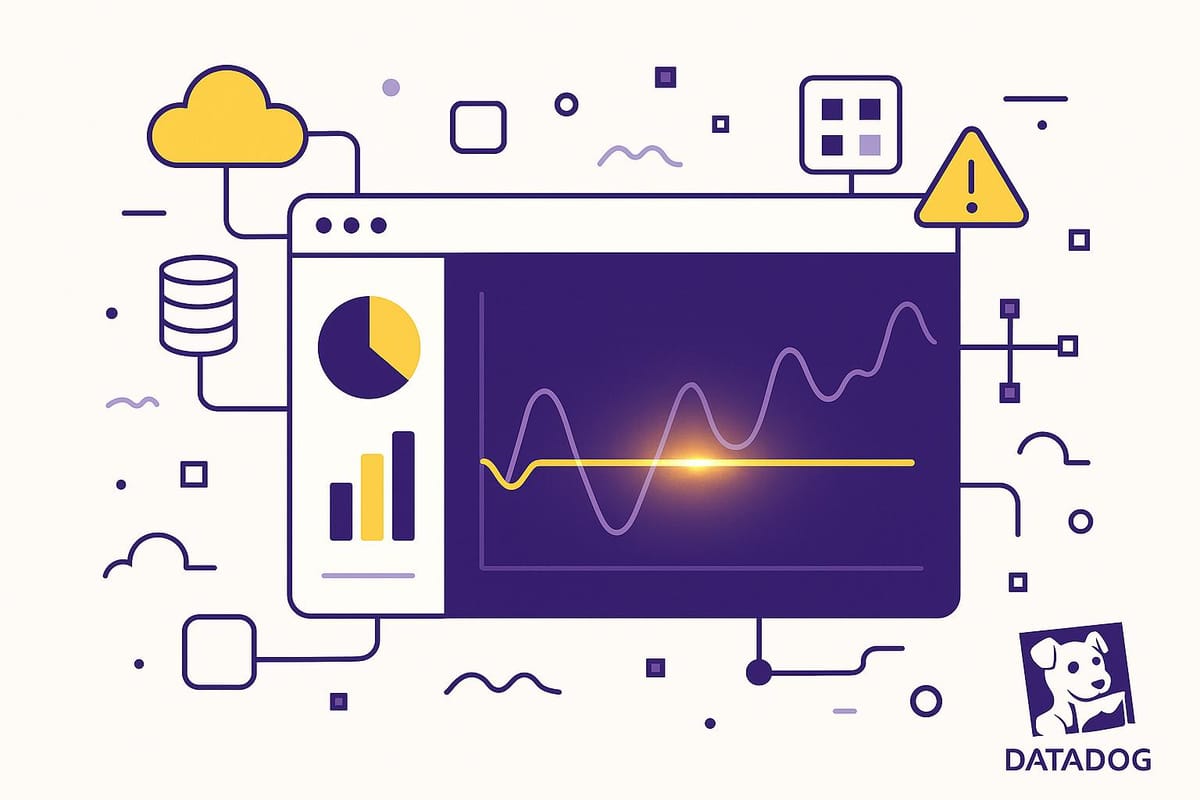
Dynamic thresholding in Datadog replaces manual monitoring with automated, smarter alerts. It uses historical data and anomaly detection algorithms to identify unusual behavior, reducing false positives by 40% and improving response times by up to 70%. Key benefits include:
- Automated Alerts: No need for manual updates; thresholds adjust based on patterns.
- Cost Control: Tag-based customization avoids unnecessary data indexing.
- Multi-Metric Analysis: Tracks multiple variables for precise alerts.
- Scalability: Adapts as your business grows.
| Static Thresholds | Dynamic Thresholds |
|---|---|
| Manual setup | Automated with algorithms |
| High false positives | Reduces false alerts by 40% |
| Basic monitoring | Detects complex anomalies |
| Limited scalability | Scales with your system |
| Requires frequent updates | Low maintenance |
Dynamic thresholds are ideal for small and medium-sized businesses (SMBs), offering smarter monitoring with less manual effort. Learn how to configure them, use historical data, and optimize sensitivity settings to reduce alert fatigue and streamline operations.
How-to: Build sophisticated alerts with Datadog machine learning
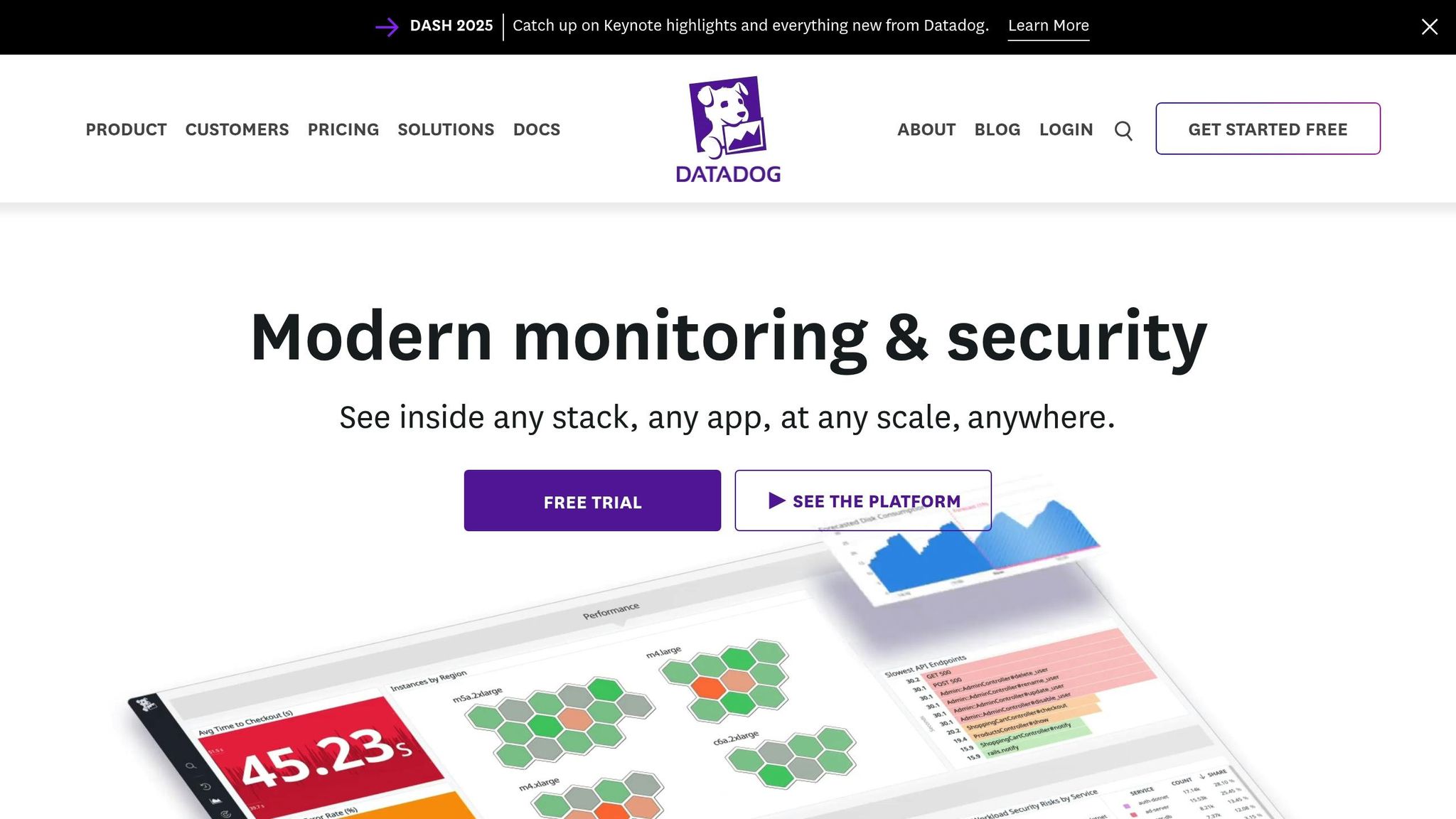
Key Features of Dynamic Thresholding
Datadog's dynamic thresholding offers a standout feature: customized alerts that adapt to your infrastructure's needs. Let’s break down what makes this tool so effective.
Granular Configuration for Custom Monitoring
Dynamic thresholding allows you to fine-tune alerts for specific metrics, services, or environments. With tag-based customization, you decide which metrics are indexed for analysis, giving you full control. For example, an e-commerce platform tracking key metrics like shopist.basket_size, shopist.sales_completed, and shopist.errors can index data by sales region. By tagging metrics with a region-specific tag, such as region, you avoid indexing unnecessary tags like customer-id or host - helping you manage costs effectively.
This level of customization not only keeps monitoring expenses in check but also sharpens your alert settings. As your business grows, you can re-index metrics to dive deeper into specific trends or issues. For small and medium-sized businesses, this precise control means lower costs and fewer false alerts, ensuring smoother operations.
How to Configure Dynamic Thresholds in Datadog
Configuring dynamic thresholds in Datadog involves a structured approach that builds on your understanding of how your systems typically behave. By following a few key steps, you can create smarter, more adaptive monitoring for your SMB infrastructure.
Setting Up a Monitor with Dynamic Thresholding
To get started, head to Datadog's monitor creation page and select anomaly detection as your threshold type instead of static values. This lets you move beyond fixed boundaries and adopt a more flexible, intelligent approach to monitoring.
When building your monitor query, focus on metrics that naturally fluctuate over time, such as CPU usage, memory consumption, or response times. Datadog's anomaly detection will analyze historical data to identify patterns, allowing you to set parameters for anomaly duration. Make sure your alert notifications include enough context to help your team quickly validate and address any issues.
For SMBs, this approach simplifies monitoring by reducing the need for constant manual adjustments.
Using Historical Data Analysis
Once your monitor is set up, historical data analysis helps refine your dynamic thresholds by creating reliable baselines. To do this effectively, your system needs enough historical data to define what "normal" behavior looks like. A look-back window of 14 to 30 days is typically sufficient to capture regular patterns, seasonal trends, and recent changes.
Adjust sensitivity settings based on how much your metrics naturally vary. Metrics with high variability might require lower sensitivity to avoid excessive alerts, while more stable metrics can be monitored with higher sensitivity to catch even subtle changes. Start with moderate settings and fine-tune them as you assess the quality of alerts over time.
Regularly revisit your historical data to ensure your baselines remain accurate. As your business grows or your infrastructure evolves, what was once considered normal may change, requiring updates to your dynamic thresholds.
Configuring Multi-Dimensional Thresholds
To take your setup further, multi-dimensional thresholds allow you to monitor the same metric across multiple services, hosts, or regions, each with its own baseline. For example, you could monitor CPU usage separately for production and staging environments or track response times for individual microservices.
When building queries, include filters for attributes that matter most to your monitoring goals. Adding details like geographic location, service version, or deployment environment helps you quickly identify whether an anomaly is isolated or part of a larger issue.
Customize your alert messages to include specific context about which dimension triggered the anomaly. Before rolling out to production, use Datadog's exploration tools to validate your queries. By fine-tuning your thresholds and excluding activities you know are safe, you can cut down on noise and ensure your alerts remain actionable. This way, your team can focus on addressing real problems without getting bogged down by unnecessary notifications.
Best Practices for SMBs Using Dynamic Thresholding
By leveraging Datadog's detailed configuration options and multi-dimensional thresholds, small and medium-sized businesses (SMBs) can ensure their alerts are both accurate and actionable. Achieving this requires a careful balance between automated algorithms and human oversight to address real issues without overwhelming teams with unnecessary alerts.
Adjusting Sensitivity to Balance Alerts
Fine-tuning sensitivity is key to capturing genuine issues while minimizing false alarms. For metrics that tend to fluctuate, like web traffic, consider setting thresholds between 70–80%, while more stable metrics, such as database connections, may work better with thresholds in the 50–60% range.
The sensitivity of your threshold - also known as the band factor - determines how closely it tracks your baseline. Higher sensitivity can detect subtle changes but might also pick up normal fluctuations as noise. Start with moderate settings and adjust over time as you validate the relevance of your alerts. Additionally, consider how the direction of deviations impacts your monitoring. For instance, upward spikes in error rates may demand immediate attention, while metrics like response times might require monitoring in both directions.
Organizations have reported up to a 30% reduction in alert fatigue by using tiered alert criteria. Regular sensitivity adjustments, paired with ongoing reviews, can help refine your system and ensure alerts remain meaningful.
Regular Review and Updates
Frequent reviews are essential to keep your monitoring aligned with changing business needs. Monthly evaluations and quarterly audits can help improve baseline accuracy and operational efficiency.
During quarterly audits, assess your threshold configurations to reflect shifts in application load and usage patterns. Identify which alerts are valuable and which ones contribute to noise. If you notice recurring false positives, it might indicate that your baselines need updating or that certain business activities, like marketing campaigns or feature rollouts, should be factored into your monitoring.
Collaboration with engineering teams is invaluable during this process. They can provide insights into expected loads and service level objectives, helping to fine-tune thresholds. For example, one SaaS provider achieved a 25% reduction in operational costs by adjusting their dynamic alerting strategies to account for seasonal trends and usage spikes. Similarly, another team reported a 30% decrease in alert noise after customizing thresholds to better reflect seasonal user behavior.
Feedback from on-call teams is another critical element. Their experience with alerts in real-world scenarios can guide adjustments to reduce false positives and improve time-to-resolution. Tracking metrics like false positive rates and resolution times will help you measure the success of your adjustments over time, naturally leading to a more layered and effective alerting strategy.
Combining Dynamic and Recovery Thresholds
Recovery thresholds are a powerful tool for preventing "alert flapping" by using separate trigger and resolve values for different alert states.
By configuring recovery thresholds for both warning and critical alert levels, you can create a more nuanced response system. Warning-level thresholds might resolve quickly for minor deviations, while critical alerts should require more substantial improvements before clearing. This approach helps your team prioritize responses based on severity.
Incorporating predictive analytics into your monitoring system can further reduce false positives by up to 50%. For added stability, combine dynamic thresholds with static ones for well-defined critical conditions, such as disk space usage exceeding 95% or memory usage surpassing 90%. This multi-layered strategy ensures your monitoring system is both responsive and reliable, striking the right balance between sensitivity and stability.
Scaling Dynamic Thresholding with Datadog for SMBs
For small and medium-sized businesses (SMBs) experiencing rapid growth, managing infrastructure complexity can quickly become overwhelming. That’s where dynamic thresholding comes into play. With Datadog, this feature streamlines alert management and scales monitoring to match your evolving needs. The next step? Codifying your monitor configurations for even greater efficiency.
Infrastructure as Code for Scalable Monitoring
To scale your monitoring effectively, treat your monitoring configurations as code. In March 2023, Globant demonstrated how combining Datadog with Terraform allows SMBs to manage monitors at scale. By using Terraform, businesses can automate and standardize their monitor configurations, making it easier for non-technical teams to provide valuable input on SLAs (Service Level Agreements) and SLOs (Service Level Objectives). This approach bridges the gap between technical and non-technical teams, enabling collaboration without requiring deep technical knowledge.
Automated Workflow Integration
Datadog's workflow automation takes incident response to the next level. It instantly triggers custom workflows based on monitor alerts or security signals, removing the need for manual checks and speeding up response times.
"With Datadog Workflow Automation, we can now automatically trigger workflows, gather critical info, and make decisions in seconds - without waking our team at 3am."
- Jeremy Stinson, Chief Architect of SaaS at Precisely.
Reducing Operational Complexity
Dynamic thresholding also reduces the need for constant manual adjustments. Unlike static thresholds, which require frequent tweaking to keep up with changing workloads, dynamic thresholding adapts automatically to fluctuating conditions. This ensures your monitoring system stays relevant even as your infrastructure evolves. Ivan Kiselev, Senior Software Engineer at Lightspeed, highlights the benefits:
"Workflow Automation helped us create an automated alert system to manage incidents more efficiently within Datadog, letting us focus on resolving issues with greater ease."
.
Resource Optimization Through Intelligence
Datadog's dynamic thresholding uses machine learning to learn normal behavior patterns and detect anomalies automatically. This reduces false positives and ensures that your alerts are actionable. SMBs can access enterprise-level intelligence without needing a dedicated data science team. Ryan Kleeberger, SRE at Protolabs, explains:
"Reacting quickly to changes in complex systems requires automation. Datadog provides an intuitive way to leverage context-rich data to automate monitor creation, update integrations, and reduce complexity and overhead in reliability and incident response engineering."
.
Strategic Implementation for Growth
To scale effectively, SMBs should focus on key performance metrics with clear numerical values, ample historical data, and predictable variability. Datadog integrates seamlessly with tools like Kubernetes, Docker, and Jenkins, enabling automated monitoring workflows that grow with your infrastructure. This ensures your monitoring system remains adaptable and efficient, helping you minimize downtime, secure your systems, and deliver a seamless user experience as your business expands.
Key Takeaways for SMBs
Dynamic thresholding takes the hassle out of manual adjustments by automatically adapting to changes in your infrastructure. This ensures that alerts stay relevant as your business grows and evolves, creating a scalable, automated system for monitoring.
One major benefit is its ability to cut down on false positives and reduce administrative workload. As Ross Banfield explains:
"Instead of hard coding, we set up alerts dynamically using instance tags - updating tags updates the monitors, eliminating overhead".
Using instance tags like "env:prod" and "slack:prod-alerts" makes it easy to scale alert routing. For example, production alerts can be sent to email and ServiceNow tickets, while development alerts are routed to Slack. This kind of setup boosts efficiency and lays the groundwork for more advanced automation and integration.
Dynamic thresholds, when combined with recovery thresholds, help reduce false alarms and prevent alert flapping. This approach ensures consistent monitoring while cutting down on the need for manual intervention.
Automation tools like Terraform make it even easier to scale these systems. Teams can update notifications simply by modifying host tags.
For SMBs, dynamic thresholding delivers enterprise-grade intelligence by automatically learning normal patterns and identifying anomalies, freeing up your team to focus on growing the business.
FAQs
How does Datadog's dynamic thresholding improve alert accuracy and help prevent false alarms?
Dynamic Thresholding in Datadog
Dynamic thresholding in Datadog takes alerting to the next level by automatically adjusting thresholds based on historical patterns and typical system behavior. While static thresholds remain fixed regardless of fluctuations, dynamic ones adapt to what's considered "normal" for your system. This makes it easier to spot real problems without getting bogged down by unnecessary alerts.
By cutting down on false alarms, dynamic thresholding allows teams to focus on the alerts that truly matter. Features like anomaly detection and forecasting ensure that your monitoring evolves alongside your system's unique trends, boosting both efficiency and reliability.
How can I set up dynamic thresholds in Datadog for my small or medium-sized business?
Dynamic Thresholds in Datadog
Dynamic thresholds in Datadog let you fine-tune monitoring alerts to reflect changing conditions, which can be especially helpful for SMBs dealing with fluctuating workloads. Although Datadog doesn’t offer fully dynamic thresholds out of the box, you can replicate this functionality by setting up multiple monitors with customized thresholds for different scenarios.
Here’s how you can get started: create separate monitors tailored to specific situations, such as peak business hours or seasonal workload spikes. Use tags or schedule downtimes to control when these monitors activate. This method effectively mimics dynamic thresholds, allowing your monitoring to stay flexible and responsive to your business demands. Make sure to test and adjust your setup regularly to ensure it aligns with your operational goals and performance metrics.
How does Datadog's dynamic thresholding help SMBs scale monitoring as their infrastructure grows?
Datadog's dynamic thresholding takes the hassle out of scaling by automatically fine-tuning alert thresholds as your infrastructure changes. Powered by machine learning, it spots anomalies and adjusts to shifting metrics, so your alerts stay accurate without requiring constant tweaks.
This is especially helpful for small and medium-sized businesses looking to keep their systems running smoothly as they expand. By cutting down on unnecessary alerts and keeping attention on what matters most, this feature allows you to grow with confidence while ensuring your systems stay reliable and efficient.


